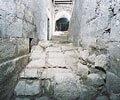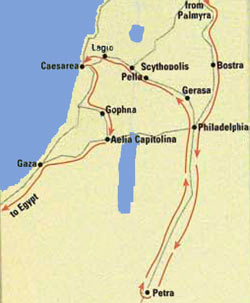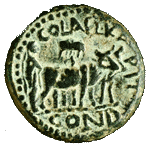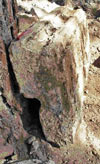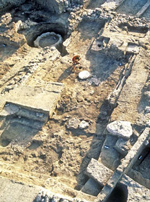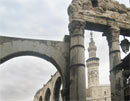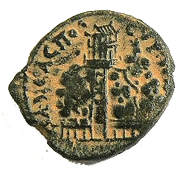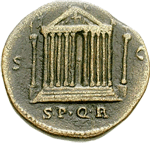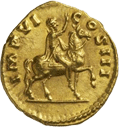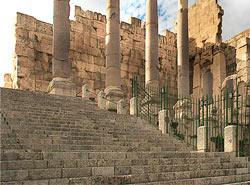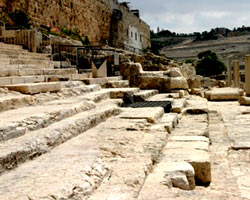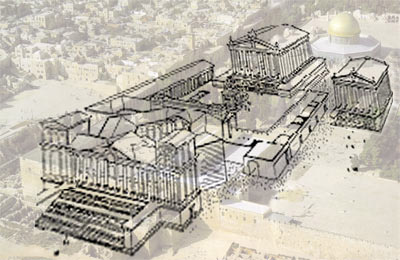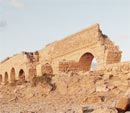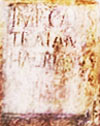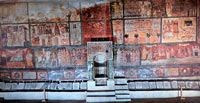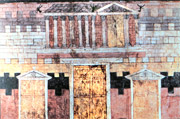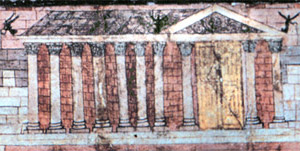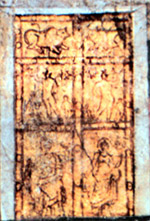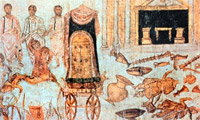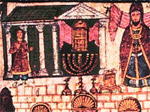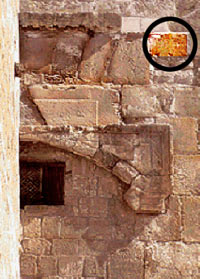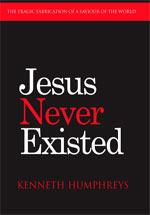A 2nd century Roman street leads to 'Temple Mount'
During 2007 archaeologists digging close to Jerusalem's Western Wall discovered a 100-foot stretch of a terraced Roman street.
The street ran from the main cardo of Roman Aelia via a bridge up to Temple Mount.
Paved with large flagstones, and passing a Roman bathhouse along the way, the thoroughfare unambiguously dates from 2nd century Aelia, as dozens of recovered coins attest.
The Israeli Antiquities Authority conceded that the find "strengthens the case" that Temple Mount, far from being an abandoned ruin after the destruction of the Jewish temple, remained a focal point in Hadrian's new city of Aelia.
Cassius Dio, the 2nd century Roman historian, states unequivocally that Hadrian built a temple to Jupiter on the site of the Jewish temple.
Plagiarizing Hadrian's Work
The celebrated "Ecce Homo" arch north of the Temple Mount, is so named because of the hoary Christian claim that here was the spot Pilate showed the scourged Jesus to the mob.
But the arch did not exist in the 1st century and it was not an entrance to Pilate’s praetorium. In fact, the arch was the central section of a three arched triumphal gateway, built by Hadrian in the 2nd century, after the Second Jewish War.
In Hadrian's day the gateway opened onto a forum and the discovery of this forum in the 19th century became the source of another Christian fable, that it was the pavement or "lithostrotos" where Jesus was "judged by Pilate" (John 19:13).
Like the triumphal arch that stands upon it, the pavement had no connection with Jesus but belongs to Hadrian's city of Aelia Capitolina.
Imperial visitor
Hadrian's tour of the east 129-130.
On this coin Hadrian ploughs a furrow (pomerium) marking the boundaries of his new city of Aelia.
In 131 the governor of Judaea, Tineius Rufus, performed the foundation ceremony at Aelia Capitolina.
Found on the Mount – Roman pedestal?
A maintenance trench dug on Temple Mount in 2007 revealed this enigmatic architrave.
With all such finds Israeli archaeologists prefer the label "Herodian" to Hadrianic yet differentiating the two is a fine judgement – as the aqueduct at Caesarea illustrates.
Temple of Dagon, Tel Qasile, north of Tel Aviv – a modest sanctuary, about 20' by 40'. It is nothing like the temple illustrations from Dura Europos, which, though they purport to represent an ancient Jewish saga, in fact, depict a Roman scenario.
Jupiter in Damascus
A remnant of the colossal Temple of Jupiter in Damascus, built in the 2nd century and parts of which were incorporated into the Byzantine Church of St John the Baptist and later, into the Omayyad mosque.
Both later buildings occupied only a small part of the vast pagan sanctuary.
Zeus on Mount Gerizim
Roman coin - Hadrian's temple, Mt Gerizim
From the lower level portico a broad stairway leads to the temple at the top of the mountain.
Later in the Roman period the sun god El-Gabal joined the pantheon worshipped here.
Hadrianic coin showing a temple to Jupiter.
Abominations
Antoninus Pius (138-161), Hadrian's successor, on horseback
KAPitolina. Coin of Emperor Antoninus Pius, stamped with a pig to delight the Jews.
Antoninus was Hadrian's successor and is universally regarded as a "good" emperor.
Compare and contrast
Temple of Jupiter, Propylaea steps, Baalbek.
Steps below southern wall, Temple Mount, Jerusalem
|
In the city of Jerusalem both Herod the Great and the Roman Emperor Hadrian built on a monumental scale. Directing public works little more than a century apart, the two monarchs built in a similar style and with a common – Roman – technology. In the later Hadrianic period material from the earlier Herodian constructions was reused, resetting the distinctive "Herodian" blocks in new locations. Both potentates wielded vast resources but an order of magnitude set them apart. For all his grandiosity, Herod was the client king of a minor kingdom; Hadrian was master of the Roman world at an apogee in the empire's fortunes. Among the resources at the emperor's disposal were the legions, the most effective instrument of construction, as well as destruction, in the ancient world. Differentiating the works of the two sovereigns is neither easy nor, in the context of current politics, especially sought after. In some quarters, Herod – the half Jew – is viewed in a poor light, but then Hadrian, the nemesis of the Jews, is castigated as a vicious tyrant: “may his bones rot” is an injunction found in the Talmud itself. Much of the material written about the temples of Jerusalem fails even to mention the edifice built by Hadrian. Great claims are made for Herod as a builder but could it be that Aelius Hadrianus was rather more involved in the sanctuary of Temple Mount than is generally supposed?
Jupiter on Temple Mount
Caesarea: Emperor Hadrian upgrades the city of Herod An example from Caesarea provides some guidance for what may have happened in Jerusalem. Herod built his famous harbour of Sebastos (Greek for Augustus) with Roman engineers, Roman technology and Roman marine concrete. The port is regarded as Herod's greatest work. But Herod's trademark city actually owes more to Hadrian than it does to the Jewish king. It was Hadrian who substantially developed and improved every aspect of the city. In the original foundation, Herod built for his own enjoyment a palace, a theatre and a racetrack and to further ingratiate himself with his Roman master, a temple to the imperial cult. The civilian city beyond the port began to develop only after Caesarea had been chosen as the seat of Roman prefects and headquarters of the 10th Legion – from 6 AD onward, a decade after Herod's death. Only then did it acquire its thorough-going Roman character. Caesarea's development actually accelerated during the conflict with Rome. The city became the marshalling point for the Roman army and in July 67 sixty thousand troops assembled here. The 5th legion joined the 10th in winter quarters in the city. Vespasian rewarded the locals with Italian rights and raised the status of the city, henceforth Colonia Prima Flavia Augusta Caesarea. After the war Caesarea grew rapidly, becoming the economic and political center of the province and hub of a new road network. Hadrian himself visited the city in 130 and again in 134, re-founding the city after extensive rebuilding which followed a severe earthquake two years earlier. The city responded with a Hadrianeum, a temple dedicated to the emperor. Herod's palace, refurbished as the governor's headquarters, was extended fifty metres further east. Herod's racetrack was shortened and redeveloped as an unusual elongated amphitheatre, with double the original seating capacity. A huge new hippodrome 460-metres long was built inland and a second amphitheatre was added on the north side of town. Pagan shrines proliferated, including a Mithraeum developed from an Herodian warehouse. From the evidence of the theatre and elsewhere, "Herodian" materials were reused in the reconstruction. By Hadrian's time parts of the outer harbour had already deteriorated. Tectonic activity had lowered the ocean floor and sunken parts of the breakwater were causing a hazard to shipping. Hadrian's repairs to the harbour included attaching a new pier to the Herodian structure in order to inhibit silting up of the inner harbour. The Hadrianic city extended far beyond the Herodian foundation and had no defining city wall for more than 300 years. To supply the city's larger population, Hadrian set the 10th legion to rebuilding the town's aqueduct. Engineers tapped into a new water source, the Tanninim River, and attached a second aqueduct to the first built by Herod more than a century earlier. Thus, there are two channels to the famous aqueduct – one Herodian, the other built by Hadrian. The style and materials of the two channels are identical and in fact are indistinguishable but for the identifying plaques of the legion. Fortunately, the legionaries who built the later channel also attached the emperor's name – or we can be sure it would all be claimed for Herod!
Almost lost – hard evidence of Hadrian's work:
The house that Hadrian built
Work on Hadrian's new city of Aelia Capitolina, which followed his imperial progression through the eastern provinces in 129-130, began peaceably enough but was interrupted by the brutal war waged by the would-be messiah Simon Bar Kosiba. When stability in the region was restored the emperor was in no mood for compromise. Any special recognition of a Jewish people was forfeit and the very name Judea was erased from the map (henceforth the province was Syria Palaestina). Hadrian, a complex and astute ruler, was deeply superstitious but also very attuned to the political dimension of religion. Throughout the provinces he restored and built temples to a variety of gods. But having witnessed Jewish intransigence at first hand he was determined to eradicate Judaism, which he saw as both cause and instigator of continuous rebellion and diametrically opposed to the cosmopolitan world empire. Judaic scholars implicated in the war were executed and teaching of the Torah was suppressed. A prohibition on circumcision had been announced before the war. Now the circumcised were barred, on penalty of death, from even entering the city of Aelia, where nothing was to remain of a sanctuary to the god of Judaism. It is more than probable that on Temple Mount Hadrian erected a temple not just to Jupiter but, as elsewhere, to all three Capitoline gods – Jupiter, Juno and Minerva. Other monuments, including an equestrian statue of himself, would have stood within the sacred enclosure. But, as religious sensitivities prohibit investigation of Temple Mount, can we be sure? Evidence that Hadrian did so build is confirmed by a number of sources, including frescos
from the synagogue of Dura Europos, physical traces in Jerusalem itself, the evidence from Mount Gerizim in neighbouring Samaria, and by written sources from the 3rd and 4th centuries.
The evidence from Dura-Europos As chance would have it, frescoes recovered from Dura-Europos ("the Pompeii of the Syrian desert") in 1932 show the Hadrianic temple of Aelia and the walls of Jerusalem. Dura-Europos was originally founded by the Greeks in their eastward expansion. In the 2nd and 3rd centuries the city was a Roman frontier settlement on the edge of the Persian (Parthian and later Sassanian) empire. Like Aelia, Dura was dominated by the presence of a Roman garrison but unlike Aelia the city had a polyglot population, patronizing a variety of cults. Mithra and the Romano-Greek deities competed with Syrian, Palmyrian, Mesopotamian, Jewish and Christian gods. In 256, with a Persian assault imminent, the city's western wall was strengthened by a defensive rampart thrown up by hastily in-filling peripheral buildings. Entombed by the soil were the city's Mithraeum, synagogue and "house-church". Recovered seventeen centuries later, all three religious buildings show a decorative style of fresco painting with clear evidence of syncretic borrowings between the rival cults. The best preserved of the frescoes were those of the synagogue, where a series of 28 wall paintings ostensibly illustrated episodes from Jewish scripture, such as scenes from the books of Exodus and Esther. What is striking in the synagogue images is that the temple depicted in the frescoes is entirely Roman in design, complete with winged putti on the pediment. Moses leads the Israelites out of Egypt through a Roman triumphal arch, wearing a white toga with a purple stripe and carrying not a staff but the club of Hercules! He is barefoot, a typical Roman motif that he stands on sacred ground. In the scene with the burning bush, the Jewish hero strikes a pose used in Roman heroic statuary to symbolize virtue. Even the smallest details are drawn from Graeco-Roman sources.
Interpreting the frescoes - Jewish Agit-Prop Among the synagogue tableaux at Duro-Europos are two images supposedly illustrating an episode from the book of Samuel. In the first, the Ark of the Covenant is held captive at Ashdod in the temple of Dagon, god of the Philistines. The temple in the frescoes is NOT at all like the temples of Dagon known to archaeology (Gaza, Beth-shan, Ugarit, etc.) but is entirely Roman. In the second illustration, the Dagon statue is overthrown and broken. Joy of joys, the ark is reclaimed by the priests of Yahweh. Thankfully, the artists refrained from illustrating God's punishment of those dastardly Philistines (1 Samuel 5) – he "smote" them with haemorrhoids! Essentially, the Dura images portray Yahweh bestowing his favours on zealots and meting punishment on unbelievers. But the message was rather more than an exercise in biblical mythology. Painted during the volatile years of the mid-3rd century, the frescoes were religious propaganda with a contemporary political value as well.
Allied to the Sassanians, Dura's Jews doubtless anticipated a return to the holy city where the "abomination of desolation" – the Temple of Jupiter – still stood. In any event, Rome was forced to abandon Dura Europos in 256.
Whispering Stones of Jerusalem
Almost totally obscured by a later Crusader tower and directly below the Al Aqsa mosque on the southern end of Temple Mount are the remains of a bricked up entrance, the so-called Huldah or "Double Gate." Set in the wall close to the lintels of the gate is a stone block, mounted upside down and bearing an inscription. It is a dedication to Hadrian's successor, Antoninus Pius. The stone is spoil from the precinct of the Temple of Jupiter, probably from the emperor's equestrian statue which stood in the temple forecourt, together with a similar statue of Hadrian himself. The inscribed stone – and hundreds of other unmarked blocks – was reused by later Islamic builders.
The evidence from Mount Gerizim
If Josephus is to be believed, it was the refusal by a Jerusalem priest of Yahweh to renounce his "impure" wife that brought about a rival temple in Samaria. His appreciative father-in-law (who happened to be the king of Samaria) assuaged the priest's lost status by building a copycat Temple of the Lord on Mount Gerizim. Evidently, during the era of Persian rule in Judea, the sinful taking of a foreign wife by Jewish males was a common enough practice:
More than three centuries later Hadrian rebuilt the temple to Zeus and it is this temple, on the northern summit of the Samaritan holy mountain, that is attested by coinage, archaeology and written sources. Excavations at Gerizim in the 1960s revealed a "technically sophisticated ... well-built structure of monumental proportions." (Prof. R. Bell). A grand stairway (identifiable on the coinage and noted by the Bordeaux Pilgrim) led up the side of the mountain to the sanctuary. Archaeologists identified two sacred precincts on Mt Gerizim, an earlier Structure "B" (60m by 40m) from the Persian / Samaritan period (5th - 6th century BC) and a later and slightly larger Structure "A" (65m by 44m) – from the Greek/Roman periods (2nd century BC - 2nd century AD) (Yitzhak Magen, 1982). Here again is a guide to the structure built by Hadrian on Temple Mount in Jerusalem. At Jerusalem, as at Mount Gerizim, Hadrian's engineers regularized and enlarged a pre-existing concourse and built a temple to Rome's foremost god.
Witnesses from the 4th century – the "abomination of desolation" Hadrian's successor Antoninus Pius (138-161) was noted for his temperate and prudent government. Yet even Antoninus had trouble with the Jews:
The Bordeaux Pilgrim records that they were still to be seen in the early 4th century, though evidently he thought both statues were of Hadrian:
Jupiter – Best and Greatest
A not dissimilar speculation has been made by the Tel Aviv architect Tuvia Sagiv, who has noted the striking similarity in both design and scale between the temple complex of Jupiter in Baalbek and the present arrangement of Islamic buildings on Temple Mount. Sagiv argues that the octagon of the Dome of the Rock was anticipated by the Roman hexagonal forecourt, and suggests the Jupiter temple faced north not south. Either orientation is possible: unlike many holy places, Roman temples were designed to be seen from the facing plaza, with no attempt at an orientation towards the sun. Superficially, the octagonal outer enclosure of the Dome of the Rock (unique in Islamic architecture) does resemble the hexagonal Jupiter "forecourt." But it more closely resembles the octagonal Church of the Ascension on the Mount of Olives (the original structure was built in the 4th century) or even the octagonal mausoleum of Diocletian, one of the last of the pagan emperors and nemesis of the Christians.
The fall of Jupiter Hadrian's erasure of the ruins of the Herodian temple was so complete and the expulsion of the Jews so effective that by the 4th century even the location of the temple edifice was beyond recall.
Stone from the ruined sanctuary was looted for use in later Christian structures. On the neglected esplanade the Byzantine emperor Justinian built a church to Mary Mother of God but little else. But when he was desperate for suitable stone to build a grandly conceived basilica in the "lower city" – the "Nea" or new church – Justinian almost certainly used the destroyed sanctuary of Jupiter as his quarry. Procopius, court propagandist for Justinian, described it thus:
Sources:
'Save' a friend e-mail this page
Copyright © 2009
by Kenneth Humphreys.
|
||||||||||||||||||||||||||||||||||||||||||||||||||||||||||||||||||||||||||||||||||||||
